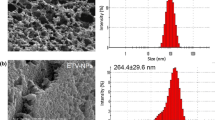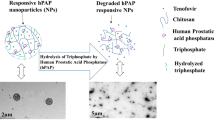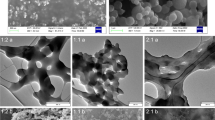Abstract
Purpose
Nanoparticles formulated from the biodegradable co-polymer poly(lactic-co-glycolic acid) (PLGA), were investigated as a drug delivery system to enhance tissue uptake, permeation, and targeting for PSC-RANTES anti-HIV-1 activity.
Materials and Methods
PSC-RANTES nanoparticles formulated via a double emulsion process and characterized in both in vitro and ex vivo systems to determine PSC-RANTES release rate, nanoparticle tissue permeation, and anti-HIV bioactivity.
Results
Spherical, monodisperse (PDI = 0.098 ± 0.054) PSC-RANTES nanoparticles (d = 256.58 ± 19.57 nm) with an encapsulation efficiency of 82.23 ± 8.35% were manufactured. In vitro release studies demonstrated a controlled release profile of PSC-RANTES (71.48 ± 5.25% release). PSC-RANTES nanoparticle maintained comparable anti-HIV activity with unformulated PSC-RANTES in a HeLa cell-based system with an IC50 of approximately 1pM. In an ex vivo cervical tissue model, PSC-RANTES nanoparticles displayed a fivefold increase in tissue uptake, enhanced tissue permeation, and significant localization at the basal layers of the epithelium over unformulated PSC-RANTES.
Conclusions
These results indicate that PSC-RANTES can readily be encapsulated into a PLGA nanoparticle drug delivery system, retain its anti-HIV-1 activity, and deliver PSC-RANTES to the target tissue. This is crucial for the success of this drug candidate as a topical microbicide product.







Similar content being viewed by others
References
UNAIDS. AIDS Epidemic Update. (2007).
R. Pool, G. Hart, G. Green, S. Harrison, S. Nyanzi, and J. Whitworth. Men’s attitudes to condoms and female controlled means of protection against HIV and STDs in south-western Uganda. Cult. Health Sex. 2:197–211 (2000). doi:10.1080/136910500300804.
M. M. Lederman, R. E. Offord, and O. Hartley. Microbicides and other topical strategies to prevent vaginal transmission of HIV. Nat. Rev. Immunol. 6:371 (2006). doi:10.1038/nri1848.
J. Turpin. Considerations and development of topical microbicides to inhibit the sexual transmission of HIV. Expert. Opin. Investig. Drugs. 11:1007–1097 (2002). doi:10.1517/13543784.11.8.1077.
P. Harrison, Z. Rosenberg, and J. Bowcut. Topical microbicides for disease prevention: status and challenges. Clin. Infect. Dis. 36:1290–1294 (2003). doi:10.1086/374834.
T. R. Moench, T. Chipato, and N. S. Padian. Preventing disease by protecting the cervix: the unexplored promise of internal vaginal barrier devices. AIDS. 15:1595–1602 (2001). doi:10.1097/00002030-200109070-00001.
T. Kawamura, S. S. Cohen, D. L. Borris, E. A. Aquilino, S. Glushakova, L. B. Margolis, J. M. Orenstein, R. E. Offord, A. R. Neurath, and A. Blauvelt. Candidate microbicides block HIV-1 infection of human immature langerhans cells within epithelial tissue explants. J. Exp. Med. 192:1491–1500 (2000). doi:10.1084/jem.192.10.1491.
T. Kawamura, S. E. Kurtz, A. Blauvelt, and S. Shimada. The role of Langerhans cells in the sexual transmission of HIV. J. Dermatol. Sci. 40:147 (2005). doi:10.1016/j.jdermsci.2005.08.009.
K. M. Fahrbach, S. M. Barry, S. Ayehunie, S. Lamore, M. Klausner, and T. J. Hope. Activated CD34-Derived langerhans cells mediate transinfection with human immunodeficiency virus. J. Virol. 81:6858–6868 (2007). doi:10.1128/JVI.02472-06.
F. Hladik, P. Sakchalathorn, L. Ballweber, G. Lentz, M. Fialkow, D. Eschenbach, and M. J. McElrath. Initial events in establishing vaginal entry and infection by human immunodeficiency virus type-1. Immunity. 26:257–270 (2007). doi:10.1016/j.immuni.2007.01.007.
M. K. Norvell, G. I. Benrubi, and R. J. Thompson. Investigation of microtrauma after sexual intercourse. J. Reprod. Med. 29:269–271 (1984).
J. P. Moore, and M. Stevenson. New targets for inhibitors of HIV-1 replication. Nat. Rev. Mol. Cell Biol. 1:40 (2000). doi:10.1038/35036060.
H. Deng, R. Liu, W. Ellmeier, S. Choe, D. Unutmaz, M. Burkhart, P. D. Marzio, S. Marmon, R. E. Sutton, C. M. Hill, C. B. Davis, S. C. Peiper, T. J. Schall, D. R. Littman, and N. R. Landau. Identification of a major co-receptor for primary isolates of HIV-1. Nature. 381:661 (1996). doi:10.1038/381661a0.
C. J. Miller, and R. J. Shattock. Target cells in vaginal HIV transmission. Microbes Infect. 5:59 (2003). doi:10.1016/S1286-4579(02)00056-4.
T. N. C. Wells, A. E. I. Proudfoot, and C. A. Power. Chemokine receptors and their role in leukocyte activation. Immunol. Lett. 65:35 (1999). doi:10.1016/S0165-2478(98)00121-7.
G. Alkhatib, C. Combadiere, C. C. Broder, Y. Feng, P. E. Kennedy, P. M. Murphy, and E. A. Berger. CC CKR5: A RANTES, MIP-1alpha, MIP-1beta receptor as a fusion cofactor for macrophage-Tropic HIV-1. Science. 272:1955–1958 (1996). doi:10.1126/science.272.5270.1955.
M. Mack, B. Luckow, P. J. Nelson, J. Cihak, G. Simmons, P. R. Clapham, N. Signoret, M. Marsh, M. Stangassinger, F. Borlat, T. N. C. Wells, D. Schlondorff, and A. E. I. Proudfoot. Aminooxypentane-RANTES induces CCR5 internalization but inhibits recycling: a novel inhibitory mechanism of HIV infectivity. J. Exp. Med. 187:1215–1224 (1998). doi:10.1084/jem.187.8.1215.
F. Cocchi, A. L. DeVico, A. Garzino-Demo, S. K. Arya, R. C. Gallo, and P. Lusso. Identification of RANTES, MIP-1 alpha, and MIP-1 beta as the major HIV-suppressive factors produced by CD8+ T cells. Science. 270:1811–1815 (1995). doi:10.1126/science.270.5243.1811.
V. S. Torre, A. J. Marozsan, J. L. Albright, K. R. Collins, O. Hartley, R. E. Offord, M. E. Quinones-Mateu, and E. J. Arts. Variable sensitivity of CCR5-Tropic human immunodeficiency virus type 1 isolates to inhibition by RANTES analogs. J. Virol. 74:4868–4876 (2000). doi:10.1128/JVI.74.10.4868-4876.2000.
D. E. Mosier, G. R. Picchio, R. J. Gulizia, R. Sabbe, P. Poignard, L. Picard, R. E. Offord, D. A. Thompson, and J. Wilken. Highly potent RANTES analogues either prevent CCR5-Using human immunodeficiency virus type 1 infection in vivo or rapidly select for CXCR4-Using variants. J. Virol. 73:3544–3550 (1999).
G. Simmons, P. R. Clapham, L. Picard, R. E. Offord, M. M. Rosenkilde, T. W. Schwartz, R. Buser, T. N. Wells, and A. E. Proudfoot. Potent inhibition of HIV-1 infectivity in macrophages and lymphocytes by a novel CCR5 antagonist. Science. 276:276–279 (1997). doi:10.1126/science.276.5310.276.
A. E. I. Proudfoot, R. Buser, F. Borlat, S. Alouani, D. Soler, R. E. Offord, J.-M. Schroder, C. A. Power, and T. N. C. Wells. Amino-terminally modified RANTES analogues demonstrate differential effects on RANTES receptors. J. Biol. Chem. 274:32478–32485 (1999). doi:10.1074/jbc.274.45.32478.
A. Mueller, E. Kelly, and P. G. Strange. Pathways for internalization and recycling of the chemokine receptor CCR5. Blood. 99:785–791 (2002). doi:10.1182/blood.V99.3.785.
O. Hartley, H. Gaertner, J. Wilken, D. Thompson, R. Fish, A. Ramos, C. Pastore, B. Dufour, F. Cerini, A. Melotti, N. Heveker, L. Picard, M. Alizon, D. Mosier, S. Kent, and R. Offord. Medicinal chemistry applied to a synthetic protein: Development of highly potent HIV entry inhibitors. Proc. Natl. Acad. Sci. U.S.A. 101:16460–16465 (2004). doi:10.1073/pnas.0404802101.
M. Lederman, R. Veazey, R. Offord, D. Mosier, J. Dufour, M. Mefford, M. Piatak Jr., J. Lifson, J. Salkowitz, B. Rodriguez, A. Blauvelt, and O. Hartley. Prevention of vaginal SHIV transmission in rhesus macaques through inhibition of CCR5. Science. 306:485–487 (2004). doi:10.1126/science.1099288.
P. Kuna, R. Alam, U. Ruta, and P. Gorski. RANTES induces nasal mucosal inflammation rich in eosinophils, basophils, and lymphocytes in vivo. Am. J. Respir. Crit. Care Med. 157:873–879 (1998).
R. Cone, T. Hoen, X. Wong, R. Abusuwwa, D. Anderson, and T. Moench. Vaginal microbicides: detecting toxicities in vivo that paradoxically increase pathogen transmission. BMC Infect. Dis. 6:90 (2006). doi:10.1186/1471-2334-6-90.
I. Bala, H. S, and K. MN. PLGA nanoparticles in drug delivery: the state of the art. Crit. Rev. Ther. Drug Carr. Syst. 21:387–422 (2004). doi:10.1615/CritRevTherDrugCarrierSyst.v21.i5.20.
S.-S. Feng. Nanoparticles of biodegradable polymers for new-concept chemotherapy. Expert Rev. Med. Devices. 1:115–125 (2004). doi:10.1586/17434440.1.1.115.
X. Gao, W. Tao, W. Lu, Q. Zhang, Y. Zhang, X. Jiang, and S. Fu. Lectin-conjugated PEG-PLA nanoparticles: Preparation and brain delivery after intranasal administration. Biomaterials. 27:3482 (2006). doi:10.1016/j.biomaterials.2006.01.038.
I. J. Castellanos, G. Flores, and K. Griebenow. Effect of the molecular weight of poly(ethylene glycol) used as emulsifier on alpha-chymotrypsin stability upon encapsulation in PLGA microspheres. J. Pharm. Pharmacol. 57:1261 (2005). doi:10.1211/jpp.57.10.0004.
J. M. Anderson, and M. S. Shive. Biodegradation and biocompatibility of PLA and PLGA microspheres. Adv. Drug Deliv. Rev. 28:5 (1997). doi:10.1016/S0169-409X(97)00048-3.
A. Lamprecht, N. Ubrich, M. Hombreiro Perez, C. M. Lehr, M. Hoffman, and P. Maincent. Biodegradable monodispersed nanoparticles prepared by pressure homogenization-emulsification. Int. J. Pharm. 184:97 (1999). doi:10.1016/S0378-5173(99)00107-6.
J. E. Oh, Y. S. Nam, K. H. Lee, and T. G. Park. Conjugation of drug to poly(D,L-lactic-co-glycolic acid) for controlled release from biodegradable microspheres. J. Control. Release. 57:269–280 (1999). doi:10.1016/S0168-3659(98)00123-0.
J. Panyam, S. K. Sahoo, S. Prabha, T. Bargar, and V. Labhasetwar. Fluorescence and electron microscopy probes for cellular and tissue uptake of poly(-lactide-co-glycolide) nanoparticles. Int. J. Pharm. 262:1 (2003). doi:10.1016/S0378-5173(03)00295-3.
T. G. Park. Degradation of poly(lactic-co-glycolic acid) microspheres: effect of copolymer composition. Biomaterials. 16:1123 (1995). doi:10.1016/0142-9612(95)93575-X.
M. Penco, S. Marcioni, P. Ferruti, S. D’Antone, and R. Deghenghi. Degradation behaviour of block copolymers containing poly(lactic-glycolic acid) and poly(ethylene glycol) segments. Biomaterials. 17:1583 (1996). doi:10.1016/0142-9612(95)00323-1.
D. K. Pettit, J. R. Lawter, W. J. Huang, S. C. Pankey, N. S. Nightlinger, D. H. Lynch, J. A. C. L. Schuh, P. J. Morrissey, and W. R. Gombotz. Characterization of Poly(glycolide-co-D,L-lactide)/Poly(D,L-lactide) microspheres for controlled release of GM-CSF. Pharm. Res. 14:1422–1430 (1997). doi:10.1023/A:1012176823155.
S. V. Vinogradov, T. K. Bronich, and A. V. Kabanov. Nanosized cationic hydrogels for drug delivery: preparation, properties and interactions with cells. Adv. Drug Deliv. Rev. 54:135 (2002). doi:10.1016/S0169-409X(01)00245-9.
T. Peng, S.-X. Cheng, and R.-X. Zhuo. Synthesis and characterization of poly-alpha, beta-[N-(2-hydroxyethyl)-L-aspartamide]-g-poly(L-lactide) biodegradable copolymers as drug carriers. J. Biomed. Mater. Res. Part A. 76A:163–173 (2006). doi:10.1002/jbm.a.30550.
C. Coester, P. Nayyar, and J. Samuel. In vitro uptake of gelatin nanoparticles by murine dendritic cells and their intracellular localisation. Eur. J. Pharm. Biopharm. 62:306 (2006). doi:10.1016/j.ejpb.2005.09.009.
L. A. Dailey, N. Jekel, L. Fink, T. Gessler, T. Schmehl, M. Wittmar, T. Kissel, and W. Seeger. Investigation of the proinflammatory potential of biodegradable nanoparticle drug delivery systems in the lung. Toxicol Appl. Pharmacol. 215:100 (2006). doi:10.1016/j.taap.2006.01.016.
N. Dinauer, S. Balthasar, C. Weber, J. Kreuter, K. Langer, and H. von Briesen. Selective targeting of antibody-conjugated nanoparticles to leukemic cells and primary T-lymphocytes. Biomaterials. 26:5898 (2005). doi:10.1016/j.biomaterials.2005.02.038.
M. J. Heffernan, and N. Murthy. Polyketal nanoparticles: A new pH-Sensitive biodegradable drug delivery vehicle. Bioconjugate Chem. 16:1340–1342 (2005). doi:10.1021/bc050176w.
C. Roney, P. Kulkarni, V. Arora, P. Antich, F. Bonte, A. Wu, N. N. Mallikarjuana, S. Manohar, H.-F. Liang, A. R. Kulkarni, H.-W. Sung, M. Sairam, and T. M. Aminabhavi. Targeted nanoparticles for drug delivery through the blood-brain barrier for Alzheimer’s disease. J. Control. Release. 108:193 (2005). doi:10.1016/j.jconrel.2005.07.024.
U. Westedt, M. Kalinowski, M. Wittmar, T. Merdan, F. Unger, J. Fuchs, S. Schaller, U. Bakowsky, and T. Kissel. Poly(vinyl alcohol)-graft-poly(lactide-co-glycolide) nanoparticles for local delivery of paclitaxel for restenosis treatment. J. Control. Release. 119:41 (2007). doi:10.1016/j.jconrel.2007.01.009.
U. Bilati, E. Allemann, and E. Doelker. Sonication parameters for the preparation of biodegradable nanocapsules of controlled size by the double emulsion method. Pharm. Dev. Technol. 8:1–9 (2003). doi:10.1081/PDT-120017517.
M. Suonpaa, E. Markela, T. Stahlberg, and I. Hemmila. Europium-labelled streptavidin as a highly sensitive universal label: Indirect time-resolved immunofluorometry of FSH and TSH. J. Immunol. Methods. 149:247–253 (1992). doi:10.1016/0022-1759(92)90256-S.
X. Wei, J. M. Decker, H. Liu, Z. Zhang, R. B. Arani, J. M. Kilby, M. S. Saag, X. Wu, G. M. Shaw, and J. C. Kappes. Emergence of resistant human immunodeficiency virus type 1 in patients receiving fusion inhibitor (T-20) monotherapy. Antimicrob. Agents Chemother. 46:1896–1905 (2002). doi:10.1128/AAC.46.6.1896-1905.2002.
J. E. Cummins, Jr., J. M. Villanueva, T. Evans-Strickfaden, S. M. Sesay, S. R. Abner, T. J. Bush, T. A. Green, J. L. Lennox, T. Wright, T. M. Folks, C. E. Hart, and C. S. Dezzutti. Detection of infectious human immunodeficiency virus type 1 in female genital secretions by a short-term culture method. J. Clin. Microbiol. 41:4081–4088 (2003). doi:10.1128/JCM.41.9.4081-4088.2003.
C. M. Finnegan, S. S. Rawat, A. Puri, J. M. Wang, F. W. Ruscetti, and R. Blumenthal. Ceramide, a target for antiretroviral therapy. Proc. Natl. Acad. Sci. U.S.A. 101:15452–15457 (2004). doi:10.1073/pnas.0402874101.
A. B. Sassi, K. D. McCullough, M. R. Cost, S. L. Hillier, and L. C. Rohan. Permeability of tritiated water through human cervical and vaginal tissue. J. Pharm. Sci. 93:2009–2016 (2004). doi:10.1002/jps.20107.
T. Kawamura, S. E. Bruce, A. Abraha, M. Sugaya, O. Hartley, R. E. Offord, E. J. Arts, P. A. Zimmerman, and A. Blauvelt. PSC-RANTES Blocks R5 human immunodeficiency virus infection of langerhans cells isolated from individuals with a variety of CCR5 diplotypes. J. Virol. 78:7602–7609 (2004). doi:10.1128/JVI.78.14.7602-7609.2004.
D. H. Owen, and D. F. Katz. A vaginal fluid simulant. Contraception. 59:91 (1999). doi:10.1016/S0010-7824(99)00010-4.
R. Bodmeier, K. H. Oh, and H. Chen. The effect of the addition of low molecular weight poly(DL-lactide) on drug release from biodegradable poly(DL-lactide) drug delivery systems. Int. J. Pharm. 51:1–8 (1989). doi:10.1016/0378-5173(89)90068-9.
L. Mu, and S. S. Feng. A novel controlled release formulation for the anticancer drug paclitaxel (Taxol(R)): PLGA nanoparticles containing vitamin E TPGS. J. Control. Release. 86:33 (2003). doi:10.1016/S0168-3659(02)00320-6.
M. P. Desai, V. Labhasetwar, G. L. Amidon, and R. J. Levy. Gastrointestinal uptake of biodegradable microparticles: Effect of particle size. Pharm. Res. 13:1838 (1996). doi:10.1023/A:1016085108889.
H. Gaertner, R. Offord, P. Botti, G. Kuenzi, and O. Hartley. Semisynthetic analogues of PSC-RANTES, a potent anti-HIV protein. Bioconjugate Chem. 19:480–489 (2008). doi:10.1021/bc7003044.
L. Vangelista, M. Secchi, and P. Lusso. Rational design of novel HIV-1 entry inhibitors by RANTES engineering. Vaccine. 26:3008 (2008). doi:10.1016/j.vaccine.2007.12.023.
Acknowledgments
The work presented was supported through grants from the National Institute of Allergy and Infectious Diseases (NIAID) at the National Institute of Health (AI-51649, Principle Investigator: Michael Lederman, Case Western Reserve University), the Pendleton Charitable Trust Fund, and the Irene McLenahan Young Investigator Research Fellowship. Its contents are solely the responsibility of the authors and do not necessarily represent the official views of the NIAID. We would like to thank the Department of Material Sciences and Engineering of the University of Pittsburgh for the provision of access to the electron microscopy instrumentation and for assistance with the execution of this part of the study.
Author information
Authors and Affiliations
Corresponding author
Rights and permissions
About this article
Cite this article
Ham, A.S., Cost, M.R., Sassi, A.B. et al. Targeted Delivery of PSC-RANTES for HIV-1 Prevention using Biodegradable Nanoparticles. Pharm Res 26, 502–511 (2009). https://doi.org/10.1007/s11095-008-9765-2
Received:
Accepted:
Published:
Issue Date:
DOI: https://doi.org/10.1007/s11095-008-9765-2




